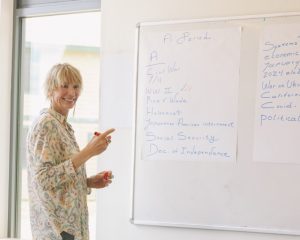The Recognition System at CRMS
Several times a year, students and their families receive a CRMS report card on progress in programs ranging from academics to service crews to interim. What catches the eye on these reports is not a grade but the large box in the center of the page that lists five character skills. Each one relates to CRMS’s core values of respect, responsibility, and excellence. This recognition system is at the heart of CRMS’s philosophy, and although that box may seem like a simple construction, the road to its creation took 15 years, several iterations, and the hard work of a dedicated group of teachers and students.
When Jennifer Ogilby became Dean of Students around 15 years ago, outgoing dean Jeff Leahy tasked her with continuing his efforts to create a recognition system. Together they began to conceptualize a means by which to measure student growth that could be woven into every part of CRMS life.
“One of the root reasons for creating the system was that at the end of the year, CRMS only recognized two people per grade through the academic award and community award. That’s great, but there were so many students who were doing the right things every day and modeling CRMS values,” says Ogilby. “We wanted to recognize each individual’s contribution to the school and also recognize where they were on a trajectory of growth towards our core values. What we know is that the more you practice something, the more it becomes a habit.”
The idea of creating a system to encourage habit building in key areas sounded fine in theory, but the implementation proved challenging, and early iterations received mixed reviews. A coach might use one system, for instance, and a teacher might use a different method. At one time, there were as many as seven or eight separate systems in circulation through a student’s day, and some included so many character skills that students didn’t even bother to read them. They focused on the numbers beside each skill instead.
Four years ago, Ogilby convened a policy committee of both teachers and students, and the group spent over a year analyzing and resolving the flaws in the system.
Universal Recognition and Language
The first aspect the committee addressed was how to create a recognition system that could be used across all CRMS programming.
“We unified it over all the program areas,” says Ogilby. “What we’re explicitly saying is that these qualities, behaviors, and habits are transferable. We expect them across all areas. They’re going to look a little different in each area, but you’re relying on certain universal skill sets.”
The benefit of that decision was that teachers, parents, and students could look at the report and notice that a student might be able to persevere in mountain biking but not necessarily in math and then discuss what qualities could be brought to both.
“The recognition system unifies all the programs because of that transference piece,” says Ogilby. “That lens can be used across all those areas. It feels so obvious now, but it was an aha moment back then.”
Next, the habits were narrowed down to five: Curiosity, Self-Regulation, Optimism, Perseverance, and Social Intelligence. Under each one, the committee carefully crafted a description.
“We wanted to create something as objective as possible so that students knew they possessed within them the ability to execute those behaviors,” says Ogilby. “We were trying to get at behaviors that ultimately, students could control. But it’s hard to create something objective. We’re still humans measuring.”
The specific language they settled on is broad enough to be used across the spectrum of a student’s life but specific enough to give them a road map of expectations to follow. For instance, under self-regulation, the first statement is “comes prepared and organized.”
“Either you’re doing that, or you’re not,” says Ogilby. “Your coach, dorm parent, and teacher are going to be thinking about whether you bring these specific areas to their particular place.”
Numbers vs. Frequency
A third change to the recognition system involved the elimination of numbered scoring. Previously the system involved a ranking from 1 to 4 for each habit. Ogilby credits Jeremy Wolf for pointing out why a number system is problematic.
“He spoke eloquently about how numbers inadvertently do something to us. We all have a relationship with numbers that we can’t explain, and they trigger something,” says Ogilby. “The numbers and calculations were taking away from the actual meaning of the system.”
Although Ogilby admits it’s not perfect, the panel created a frequency index using “Mostly,” “Sometimes,” or “Rarely” to mark progress instead of numbers.
“They’re the most objective terms to wrap your head around,” she says. “The student mostly, sometimes, or rarely hands in their homework. The desire was to make it about frequency instead of numbers.”
As the panel wrestled with the language, they continued to return to the primary purpose of the system, which was to identify areas of growth and to measure growth over time.
“We want ‘mostlys’ walking around the school,” Ogilby says. “It’s perfectly fine for everyone to be a ‘mostly.’ We don’t want unachievable recognitions.”
Partly to that end, the Holden Scholar academic recognition was broadened to become known as Holden Citizen and encompass all aspects of student life. Students must have primarily “Mostly” on their reports across the spectrum of CRMS programming to qualify for this designation. Otherwise, they’re considered a CRMS Citizen (a student still working towards more “mostlys”) or in the Support Community, which is a student needing extra support. Unlike the High Honor Roll list that is posted in the Bar Fork, however, these categories appear only on the reports. The school continues to look for ways to honor and celebrate that achievement.
The Student Meeting Block
A fifth result of the policy committee’s work has been implemented only in the last two years. According to Ogilby, the policy committee students’ biggest issue with the recognition system was that students didn’t have enough time to connect with their teachers over it.
“They’d get these report cards, but they didn’t have an opportunity to dialogue with their teachers about it,” says Ogilby. “They’d say one of the goals is to promote communication, but we’re not really communicating.”
In response, the student meeting block was introduced into the schedule last year to create a dedicated time for students to meet with their teachers. The ultimate goal is that students practice seeking out help, advocating for themselves, and talking with their teachers– skills that are critical in the college years. The meeting block, which happens every Thursday now, is a well-received new addition to the schedule.
Habits Matter
Anecdotally, Ogilby says these changes to the recognition system have been well-received across the CRMS community. Although some language tweaking may still be necessary, she doesn’t hear about the level of problems that existed with the old systems.
“People got behind introducing the system in classes, crews, sports, and the dorms and defining those qualities in their areas. That’s felt really good,” she says.
Recognizing students for values and skills as well as grades has never been more important, either. In September, The Washington Post reported that students in high achieving schools are now considered an “at-risk” group for issues like chronic stress, anxiety, and substance abuse because of society’s overarching pressure to achieve. The article pointed to a 2017 study in the Journal of Youth and Adolescence, which found that students who believed their parents valued character traits as much as or more than achievement exhibited better outcomes and mental health.
“These recognition categories are important,” says Ogilby. “Who cares if you go to Harvard if you can’t function there?”
Next time you open a CRMS report card, take a moment to notice how the recognition box takes center stage. Like so much of the work done at CRMS, the thought that went into that box is extremely important to student growth. The recognition system isn’t static on a piece of paper, either.
“We often talk about how we can bring the program to the student,” says Ogilby. “We’re not just saying, hey, get with the program. We can help them to improve and enact support so that they can find success. We want them to find success because then it just builds from there.”
To learn more about Colorado Rocky Mountain School, please join our mailing list, request information or apply now.
 MYCRMS
MYCRMS





 Virtual Tour
Virtual Tour

